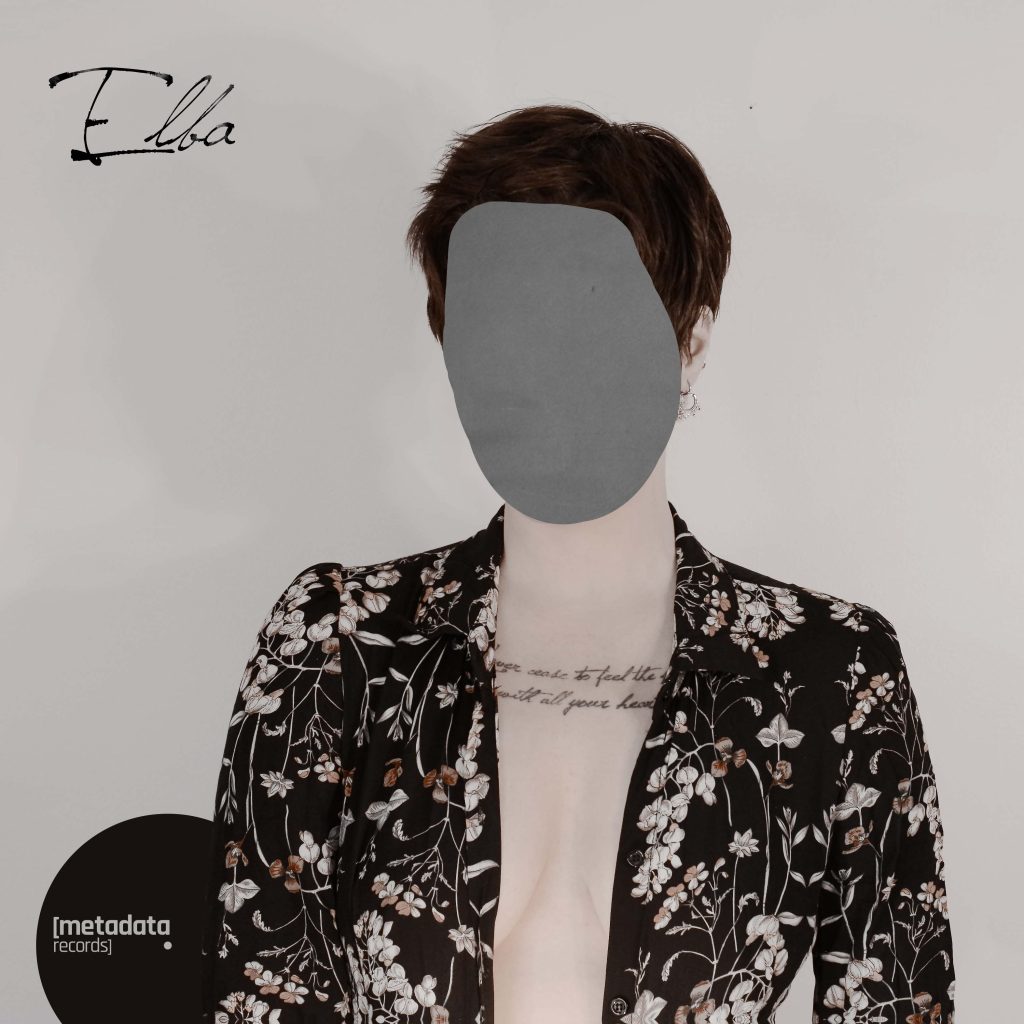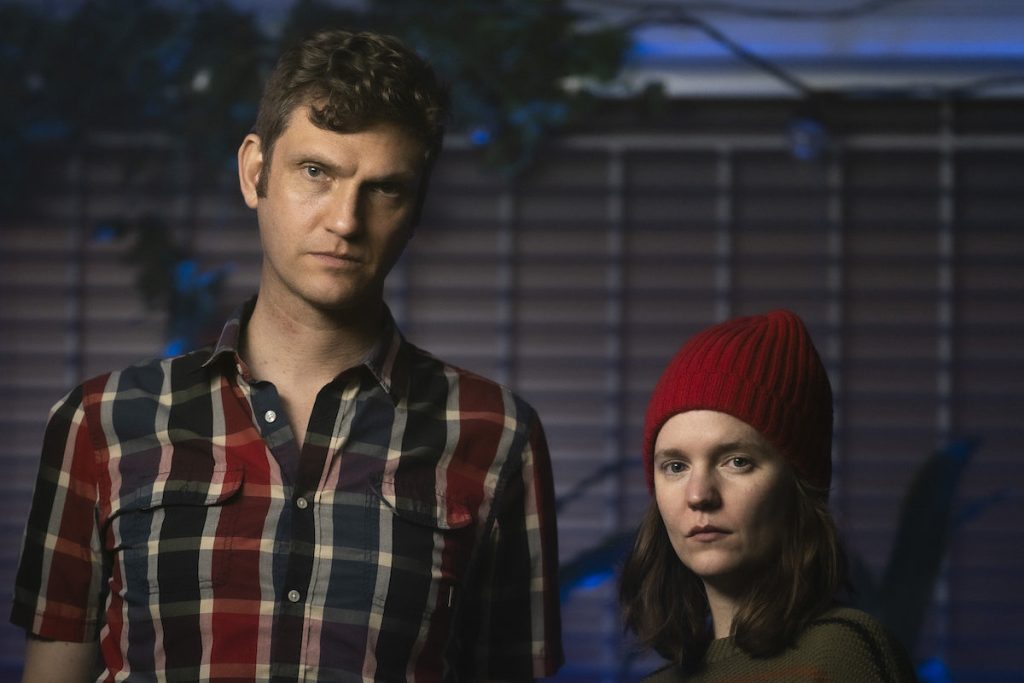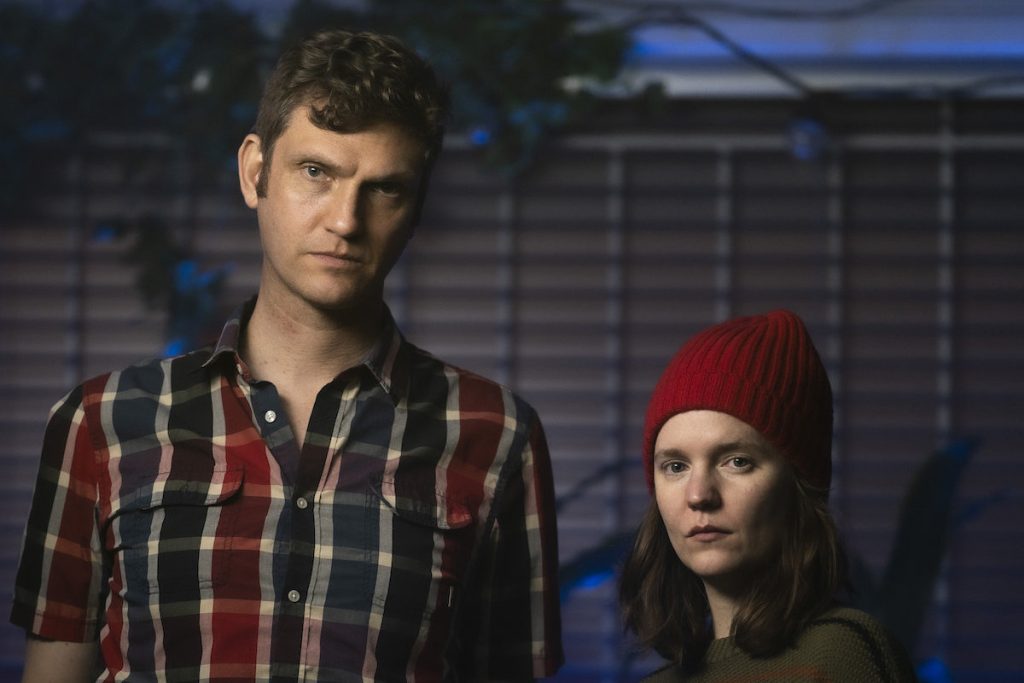Canadian duo Elba are set for the release of their debut record, a beguiling eight track affair that dances the line between heartfelt songwriting and twisted electronics. We caught up with the pair to discuss their music, process and influences.

Elba - Interview
Welcome Jonathan (Dark Arps) & Amber (amsii), thank you for joining us at Minimal Mag to reveal some of the secrets behind your release under the new moniker ELBA. How did you two meet and where did the idea of working together come from?
Amber: Leading up to Jon and I meeting, I was diving in and out of different bands and groups and experimenting to expand my predominantly folk acoustic world. I was rather keen to work with a producer who had a strong electronic music background and was on a bit of a hunt. My roommate Michael, who knew Jon through the techno events Jon was throwing in Vancouver, felt inspired to connect us. Originally, Elba was a solo project and I was going to hire Jon as the producer. With how we work together it became apparent a few months in that this needed to be a duo and the collaboration was born.
Jon: Ninety-nine times out of a hundred, when someone enthusiastically texts you out of the blue to rave about their ‘talented roommate’, that roommate has no talent… but I like to keep an open mind, and Michael’s a fascinating, unusually gifted individual, so I had a feeling this would be something very interesting. He must have sneaked his mobile into the jamb of the door while Amber was working on her material. When he sent me that first demo, my response was: “this is your roommate… not… Erykah Badu?!” I thought her voice and delivery was a dead ringer for that jazzed up soul sound on Baduizm, that’s an album I listened to a lot. At the time, apparently Amber was writing a song a day. Those early cell phone recordings sounded like shit, and that’s how I knew I was dealing with an incredible talent because a quality vocal and strong melodic composition will cut right through, no matter how poorly recorded.
Amber, could you please tell us something about the origin of the artist name and release title?
The name Elba was my grandmother’s middle name. My grandmother was a pretty spectacular woman. That entire side of the family, my mom’s side, are musicians: great grandparents, grandparents, uncles. Music was always a given– always present. I wanted to honor that heritage somehow and the name became that tribute.
The release covers many genres, could you cite some influences for the EP? What was the goal for this project?
Amber: I didn’t have any specific influences, beyond simply wanting to ‘emote’… about… existence, life, whatever was happening around me. At the time it was about relationships, personal growth, small drama. This project was an emotional outlet, and that became the focus. I’ve always been really protective over whatever I create so, sending the first track and giving Jon full creative autonomy on his end was really tough for me – in that sense, this project became about letting go of that control.
Jon: At the core I’m all about dance music, always have been, I actually can’t hear lyrics, only melody really matters for me. So, first and foremost it’s about creating a unique, compelling rhythm section as a backbone for the songs. The drums and bass, and the underlying chord structure come together to create an inspirational, surging energy, while the vocals and other “top-line” melodies are articulating the more complex emotional language of the music… but it always must be underpinned by a very solid, hard-hitting groove. Artists and bands like Portishead, Massive Attack, and Tipper were the core influences for me here, but there are so many more I could or should mention.
Amber, your lyrics and delivery of them are incredible. Could you share something about your songwriting workflow and the way this translates to the finished product, specifically while working together?
Thank you! I appreciate that. Singing and writing are the most significant artistic endeavors in my little world. I started writing as a therapy when I was a teen to confront and process bullying. Soon after my first songwriting attempt I utilized this tool to grieve several significant deaths in the family. I never really knew what I was going to be writing about when I started; I just had to get the feelings weighing on me out of my body and on paper. In that way, I started working intuitively. From listening to music, playing in school band, piano and guitar lessons and singing at church I had a grasp of what a song structure looked like and so I mimicked that ABABCB template. Even with some of the technical training I’ve had I write pretty much the same way I did when I was thirteen years old. I start with a single line of thought and build the story one line at a time. When the draft is complete sometimes the story is crystal clear– while other times I have to interpret what the heck my subconscious was trying to say, haha. With the Elba project I start in a similar fashion. I send an edited draft to Jon and once it’s back I go over everything I’ve written to ensure things fit comfortably. This process can take a few runs… As for instrumentals, writing with my guitar or uke the melodies and chord progressions build similarly to the way I write… it all grows simultaneously– one line, one section at a time. When I started to delve into electronic music that process changed. I focus on the instrumental first and once that has been fleshed out I think about lyric and vocal performance.
Jonathan, you’ve built an impressive catalog of dance music as Dark Arps since starting Metadata records. What was it like to shift towards the experimental pop-leaning tracks of Elba?
I’ve probably been working towards something like this the entire time I’ve been plugging away as a producer. Pop music was at the foundation of my love for electronic, because pop was, all of a sudden, very electronic in the early to mid 90s, right at that crucial time when I was young and at my most impressionable. It all started with those NOW compilations: Snap, C&C Music Factory, Baby D, The Shaman, Utah Saints, The KLF, Inner City, Faithless… I was also (and still am) a fan of George Michael, Depeche Mode and INXS before the 90’s dance pop revolution came along, but come the late 90s my tastes had matured and I started listening to The Prodigy, Roni Size and Reprazent, Leftfield, Fatboy Slim, MJ Cole, The Propellerheads, Portishead, Massive Attack, DJ Shadow, UNKLE, Underworld, and Hybrid… often there would be vocals and a pop music sensibility at the core of what these acts were doing, but they managed to toe a line between catchy accessibility and edgy, “for the heads” legitimacy, and I’ve always imagined that was something I could do. That said, I didn’t mind admitting to having a deep admiration and appreciation for certain mainstream pop music acts like Kylie Minogue or Britney Spears. ‘Toxic’ is one of my favourite pop productions ever. There’s a cabal of genius composers, engineers and producers behind tracks like that and I have always had a lot of time and respect for that kind of work.

You also have an impressive skill set across a whole range of disciplines. Can you tell us something about your other artistic outlets and how they influence your music?
I tend to call myself a “technical artist”, because music production and digital art are very technical endeavours, and I like to fully understand how things work so I’m not guessing when I try to create. The big picture goal for [mdr] is for me to be able to produce animated visualizations and graphical compositions in much the same way that I produce the music, and to eventually combine the two into one holistic package, where the audio and MIDI influence the parameters of the visualizations, and perhaps eventually, vice-versa. My day-job is as a “media producer”, which means I create graphic design and video content for clients, and over the past few years in particular, I decided to focus much of my attention on mastering a couple of specific software applications, namely After Effects and Houdini, which allow me to create 2D and 3D animated visualizations for clients. Unreal Engine is the next on my list as it will allow for real time rendering, which means an interactive experience, which I may eventually be able to bring to live performances. As it happens, if you want to learn computer graphics, you need to commit to learning computer programming because that’s what computer graphics are: a programming language. Maybe the software wraps it all up in an attractive GUI for you, but a lot of the time it doesn’t, and there’s an infinitely deeper level of control and power available to you as a creator if you can write short lines of code to get the computer to do the grunt work for you. A couple of years ago I started to learn to write code, something I never thought possible. Pretty soon I will be able to leverage this back towards making actual art again, but it’s been extremely slow-going, and it definitely gets in the way of actually making music. It’s not uncommon for me go for weeks or months without actually producing any tracks, because if my headspace is into learning code and working in 3D right now, it’s difficult for me to change direction and suddenly be flexing on music… I prefer to zone in for longer periods before coming up for air to change focus.
What were some of the challenges and achievements behind the scenes of this album?
Amber: One of the challenges was, again, letting go of the control. Busy Bodies was our first track together and was in many ways the biggest challenge for us working as a team because we were just getting to know one another. Also, it was and is the biggest departure from the original demo that I sent: Jon’s adaptation of the original instrumentation is vastly different, it was initially intended as an acoustic jazz piece, but turned into this weird, wobbly anthem. For both of us, it took patience, and throughout the process we both grew as musicians and composers… the achievement is ‘Elba’, and our friendship, and the distillation of our craft, which will continue on. I learned a lot about what collaboration could be when I allowed the process to take the wheel, when I listened to what the song needed instead of trying to impose myself onto it. With Jon’s first rendition of Busy Bodies it became clear that the original vocal had to go and what he created for this track needed to be the focus. I wrote new lyrics and re-recorded, adapting melodies.
Jon: The challenge for me was, similarly, getting Amber to see things my way. As a producer, I’m also trying to be an artist, and when you’re foisting your ideas on someone else’s art, things can sometimes get a little edgy. Both for her (“hey what have you done to my song?”) and for me (“hey why can’t you get what I’m trying to do here?”), there’s this initially awkward phase, especially after sending the first bounce, where I’m hoping she will understand what I’m driving at, instead of wanting to change everything about it. Maybe my ideas aren’t fully fleshed out – when you have an idea in mind but you haven’t quite nailed the execution, it probably won’t translate very well, and nobody can hear what you have in your mind. But the whole time, I somehow felt confident that she would eventually get where I was coming from and come to love what we had created together. As each subsequent track came together, the length of that awkward phase was reduced. I understood when she needed a little time to come around to a new idea, and when it was going to be a flat-out ‘no’. The whole album is one big achievement as far as I’m concerned. I always felt very confident about what we created, and we were always met with very positive responses from our peers when we auditioned the music to them. I’ve always felt confident that we had a hit on our hands.
Both of your solo projects are amazing, how did you feel like your previous work prepared you for Elba and for working together?
Amber: I have been songwriting since I was thirteen. In that regard, 20 years later, songwriting feels second nature to me. My first solo release was in 2011. I really stretched myself on that release, and yet, when I reevaluated a year later it was apparent I needed some work. I decided to enroll in the songwriting certification through Berklee College’s online program in 2012. In 2013, I enrolled in a BFA program with Emily Carr University and graduated with a minor in writing. Both of these programs polished the writing but there’s always a long way to go and a lot I can improve. That being said, pumping out tracks for Jon to bend and manipulate is ideal for me. I’ve spent countless hours writing and at the end of the day, my “band” experience is limited. I have a need for a lot of autonomy and alone time in my writing and composing practice. I feel that my experience is perfectly catered for a set-up like Jon and I have– I write and then send the track off and a few weeks later I receive a track back, see what needs to be edited, send new vocals and notes and we go from there.
Jon: It’s important to point out that there’s a lot more to my production history than the solo dance projects, although that’s where the heart and passion has always lived. I’ve been producing since ‘97 and a significant chunk of that time was spent performing in/working with jazz, rock, hip-hop bands, acoustic singer-songwriters, classical composers and other weird-o musical outfits, lending my technical acumen as well as providing support in the form of composition and creative sound design, to help them realize their ideas. I spent my 20s in the UK soaking up as much variety of experience as I could, rather than being laser-focused on one particular style of music or technical discipline. I was in a touring band called Keiretsu, a multi-genre dance-music orchestra of sorts, which was an indescribable live experience and to which I owe an incredible amount. I should also mention another collaboration I’ve been involved with since 2000 (and which is still going), called ‘Beamer Grande’, where I act as mix engineer, sound designer and producer for the compositional genius of Richard Meehan, who is undoubtedly the most talented and capable musician I have ever known. He composes impossibly complex and bombastic pop and orchestral masterpieces, hires his friends to perform those compositions on strings, brass, woodwinds, and vocals, and sends the sessions to me to program beats, articulate MIDI basslines, and provide other creative sound design ideas, finally balancing it all into a cohesive mix. I try my best to keep up. I owe a lot to and am grateful for every one of those collaborations – that learned perspective and breadth of experience gives me a unique vantage point as a producer to be able to create an album like Elba. In fact it is highly likely Richard could be involved with Elba in some capacity in the future… if Amber allows it!
Jonathan, your imprint Metadata Records previously served as an outlet for your own work as Dark Arps, can we expect more Elba on the label in the future? Can you reveal something about your plans for it?
Absolutely, there will be more Elba on Metadata Records, just as soon as we can find the time to make it. We’ve decided to only make albums, not EPs and, while I’d love for us to be cranking one out every six months, the reality is that this kind of quality takes time, we both have day-jobs and I’m already juggling far too much. That said, our workflow starts with Amber’s composition of an initial skeleton track, and she is in that mode right now so the process has already begun… rest assured, there will be a follow-up Elba album in 2023. Until then, my plan is to produce several collaborative EPs: Dark Arps & ______, all of which will be dancefloor music spanning a range of tempos, anywhere between 105 and 180bpm, four-on-the-floor or broken beat… I want to avoid creating expectations regarding genres for the label, but all of the music released on [mdr] will be my productions, my mixes and my masters, so there will be cohesion in that regard. I have no plans to sign other artists to release on [mdr], but, as long as I had a hand in creating the music in some way, it’s fair game. I want to give myself and anyone else who works with me on a [mdr] release the freedom to do whatever we want with it, stylistically, so expect downtempo, house, techno, breaks and drumnbass, maybe cinematic and ambient, there could be collaborations with other vocalists. I like to keep my options open. To fill up the rest of the 2022 release schedule, I’ve teamed up with a number of different producers in the local community here in Vancouver and already have several EPs in the pipe to follow up with, starting in the spring.
Elba - Links
Get in touch with us!
0
0
votes
Article Rating

